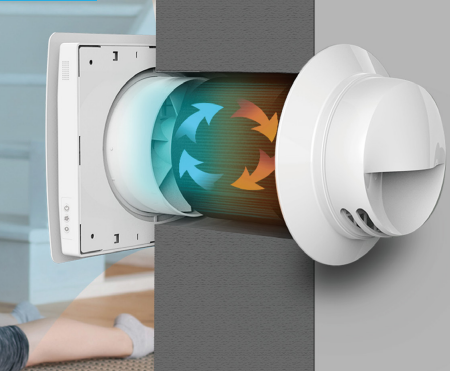How HRV Regulates Indoor Climate
Wiki Article
Discovering the Conveniences of Heat Recovery Ventilation for Energy Efficiency in Houses
Heat Recovery Ventilation (HRV) systems provide homeowners a sensible technique to enhancing power performance. By redeeming warm from outgoing air, these systems can substantially decrease heating & cooling prices. In addition, they provide a constant supply of fresh air, improving interior air quality and comfort levels. As property owners consider lasting alternatives, understanding the nuances of HRV systems becomes increasingly essential. What elements should one review prior to making such a financial investment?Recognizing Heat Recovery Ventilation Equipments

Just How HRV Improves Indoor Air High Quality

Power Financial Savings: The Economic Advantages of HRV
Maximizing power performance, heat recovery ventilation (HRV) systems supply significant monetary advantages for homeowners. By recuperating and reusing warmth from exhaust air, HRVs markedly lower heating and air conditioning prices. This technology can lead to power cost savings of as much as 30%, relying on environment and use patterns. Home owners usually observe reduced energy bills quickly after installation, making HRVs an economically sensible investment with time. Additionally, several areas provide rewards or refunds for energy-efficient upgrades, further improving the financial allure. As power prices continue to rise, the cost-effectiveness of HRVs comes to be significantly clear. Overall, the consolidation of HRV systems not only advertises power performance however likewise adds to long-term economic cost savings for homes.The Environmental Influence of Heat Recovery Ventilation
A considerable ecological advantage of heat recovery ventilation (HRV) systems depends on their capability to reduce general energy consumption. By recovering heat from exhaust air and moving it to inbound fresh air, HRV systems minimize the need for energy-intensive home heating and cooling approaches. This decrease in power need adds to decrease greenhouse gas discharges, as less fossil gas is called for to preserve comfy interior temperature levels. In addition, HRV systems boost indoor air top quality by successfully trading stagnant air with fresh exterior air, reducing dependence on mechanical air conditioning systems that can harm the environment. Overall, the implementation of HRV systems supports lasting living practices and lines up with global efforts to deal with environment adjustment by advertising power efficiency in residential settings.
Picking the Right HRV System for Your Home
Just how can property owners ensure they select the right heat recovery ventilation (HRV) system for their demands? First, they should assess their home's dimension and design, as these factors affect airflow requirements. Next off, examining the system's effectiveness scores is vital, as higher scores show far better efficiency and power cost savings. Homeowners must additionally think about installment and maintenance prices, comparing different brands and versions for worth. In addition, it's crucial to evaluate noise degrees, as some systems run even more silently than others. Consulting with cooling and heating specialists can give tailored suggestions based upon particular home problems. Examining customer testimonials and guarantees can assist in making an educated decision, ensuring that the picked HRV system effectively improves interior air quality and power efficiency.Regularly Asked Questions

Just how Commonly Should I Tidy or Maintain My HRV System?
The regularity of cleansing or preserving a heat recovery ventilation (HRV) system typically depends upon usage and ecological variables. Generally, it is advisable to do maintenance every six months to ensure peak efficiency and air top quality.
Can HRV Systems Help In Reducing Moisture Levels Inside?
HRV systems can effectively decrease interior humidity levels by exchanging stale, damp air with fresh, drier air from outside. HRV Heat Recovery Ventilation. This procedure assists keep a HRV Heat Recovery Ventilation well balanced interior atmosphere, improving convenience and protecting against moisture-related issues
What Is the Life expectancy of a Normal HRV System?
The life expectancy of a normal heat recovery ventilation (HRV) system varies, generally lasting between 10 to 15 years. Regular maintenance can prolong its performance and operational life, guaranteeing peak efficiency throughout its usage period.Are There Any Sound Interest In HRV Solutions?
Sound problems with HRV systems can arise, especially from fan operation. Nevertheless, several contemporary systems are designed to decrease sound levels, guaranteeing they operate silently while preserving efficiency, which attends to potential disruptions in living settings.Can I Mount an HRV System Myself, or Do I Need an Expert?
The private contemplated whether to set up the heat recovery ventilation (HRV) system personally or hire an expert. Typically, while do it yourself installment is feasible, experience warranties appropriate capability and conformity with regional building ordinance, enhancing system performance.Report this wiki page